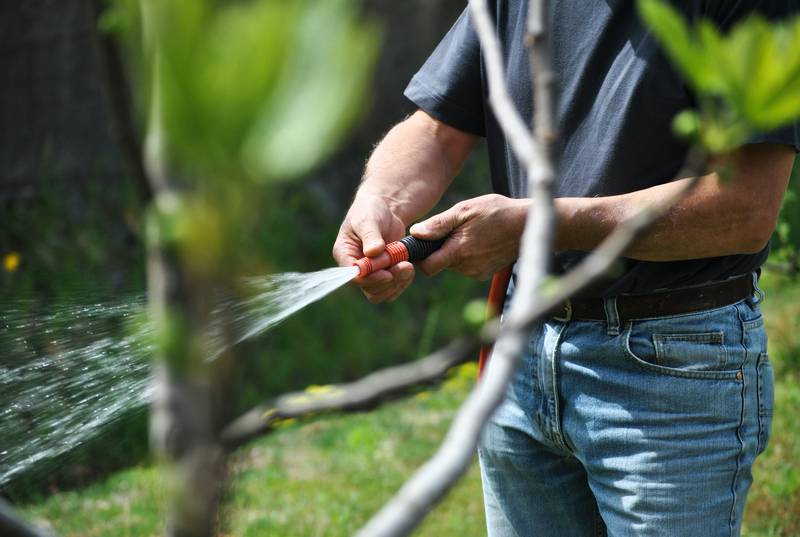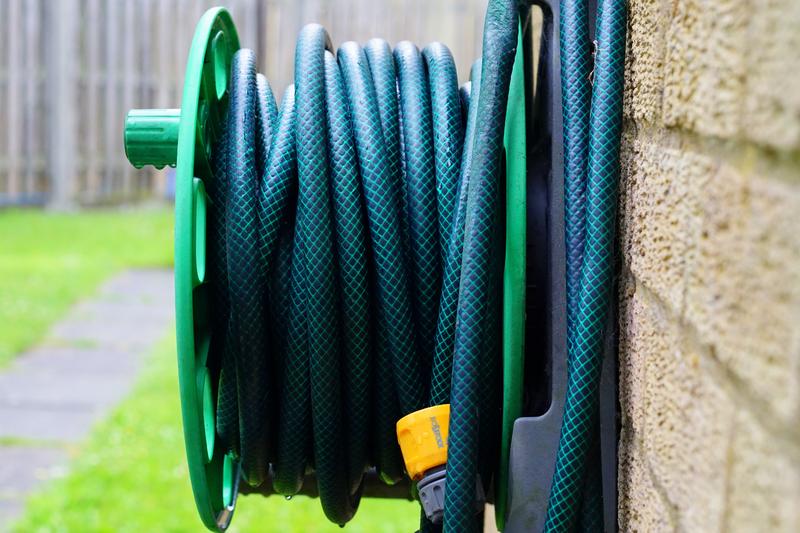How to Stop Dog From Chewing Garden Hose [5 Easy Steps!]
Is your dog chewing your garden hose constantly and you’re not sure how to make them stop? You’re in the right place! This article will explain why dogs love to chew water hoses and how you can prevent this behavior.
We’re going to explore the reasons why dogs bite water hoses and help you pick a hose that your dog won’t be able to destroy. For those of you wondering why your dog might be scared of the water hose, we’ve got answers.
Finally, we’ll discuss why dogs seem to enjoy biting at the water coming out of the hose and whether the water from your hose is safe for your dog. So, if your garden hose has become your dog’s new favorite chew toy, keep reading below!
How to Stop Dog From Chewing Water Hose?

To stop your dog from chewing on your water hose, you can use a combination of redirection, positive reinforcement, providing chew toys, using smell deterrents, and keeping the hose out of reach.
Here’s how to apply these methods:
- Redirection: When you catch your dog chewing on the hose, use commands like “leave it” or “drop it” and redirect their attention to a more suitable object, such as a chew toy. This teaches your dog what items are acceptable to chew on and can help to break the habit of chewing on the hose.
- Positive Reinforcement: Use treats, praises, or petting to reward your dog when they chew on their toys and leave the hose alone. Positive reinforcement encourages good behavior by rewarding your dog for making the right choice.
- Provide Chew Toys: Giving your dog a variety of chew toys can help deter them from chewing on the hose. Chew toys not only satisfy your dog’s natural urge to chew but also keep them occupied. Make sure the toys are safe and suitable for your dog’s size and chew strength.
- Smell Deterrents: Applying scent deterrents to the hose can discourage your dog from chewing it. Make a 50/50 mix of distilled white vinegar and water, spray it on a cloth, then wipe down your hose with it. The smell will go away after about an hour but your dog will continue to be repelled.
- Keep Hose Out of Reach: If possible, store the water hose in a place where your dog can’t reach it. This can be an immediate solution to prevent your dog from chewing the hose. However, it’s important to remember that this method doesn’t address the underlying issue of why your dog is chewing in the first place.
These steps will get your dog to stop chewing the water hose, but it’s important to remember that the underlying behavioral issue (anxiety, boredom, attention-seeking, etc.) that was causing all of this to begin with will still be present. And until you address that, any positive changes you see are only going to be temporary.
“So, how do I make these changes last?”
By getting your dog to truly choose to follow your direction, that’s how. I tried many times to write out how you can do that before deciding it made more sense to just link you to the free video series that explains it better than I’d ever be able to.
The series is by a man named Dan who is one of the world’s leading dog obedience trainers. In it, he teaches you how to put an end to things like when your dog chews the water hose and all other misbehavior using his fast and easy-to-follow methods.
In the first video, Dan will reveal to you why the two most common methods of dog training only doom you to failure. You can watch the video now by clicking here. Follow the proven system he’ll show you in his series and you’ll never have to spend another second worrying about your dog chewing the water hose ever again!
Why Do Dogs Bite Water Hose?

Dogs bite water hoses due to a variety of reasons including soothing anxiety, satisfying their playful nature, instinctual chase behaviors, and relief from teething discomfort. These behaviors can be effectively managed through a combination of training, redirection, and providing suitable chewing alternatives.
Soothing Anxiety
Anxiety can lead to a number of behaviors in dogs, one of which includes chewing. Chewing is a natural stress reliever for dogs and biting a water hose might be one way your dog is attempting to soothe themselves. If your dog is often left alone or experiences changes in their environment, they might resort to chewing on objects like a water hose for comfort.
Playfulness and Predatory Instinct
One reason dogs bite water hoses is that it’s fun for them. Dogs are naturally playful and curious, and a water hose provides a moving target that they find engaging. The water’s movement mimics the unpredictable movements of prey, triggering their predatory instincts. The hose itself, being flexible and moving when water runs through it, can also simulate the wriggling action of a small animal, further enticing the dog to bite or attack the water hose.
Teething and Chewing Desire
Dogs, especially puppies, have a strong desire to chew. This behavior is often intensified during the teething period, as chewing helps soothe the discomfort associated with incoming teeth. The water hose, being a chewy, flexible object, provides a satisfying outlet for this need. Even adult dogs who aren’t teething might still enjoy the physical sensation of chewing on a water hose.
Attention-Seeking
In some cases, dogs might bite the water hose because it gets your attention. If you react strongly, either by laughing, shouting, or chasing them, they might learn to associate the behavior with receiving attention from you. This can reinforce the behavior, making them more likely to repeat it.
Managing the Behavior
Managing this behavior involves a combination of training, redirection, and providing appropriate chew toys. Training can involve teaching commands like “leave it” or “drop it” and rewarding your dog when they obey.
Redirection involves distracting your dog with another activity when they start showing interest in the hose. Providing a range of appropriate chew toys can help meet your dog’s need to chew, reducing their interest in the hose. (We explain more on this process in the first section.)
Dogs bite water hoses for a variety of reasons, but this behavior can be effectively managed with the right strategies. It’s crucial to address things before the problem gets any worse. Otherwise, you’ll soon also find your dog chewing on water bottles, chewing on plastic, chewing on your door mat, chewing their water bowl, or even chewing on your headphones.
Water Hose Dogs Can’t Chew: What to Look For
When looking for a water hose that dogs can’t chew, you should consider its material, thickness, durability, flexibility, and whether it’s covered with a protective layer.
Here’s what to look for in detail:
- Durable Material: One of the key factors to consider is the material of the hose. Some materials, such as rubber or reinforced nylon, are known for their durability and resistance to chewing. These materials can withstand the wear and tear of a dog’s teeth better than others.
- Thickness: A thicker hose is typically harder for a dog to chew through. Thicker materials can provide an extra layer of protection against a dog’s teeth, making it more difficult for them to cause significant damage.
- Protective Layer: Some hoses come with a protective layer or casing made of a tough material like steel. This layer acts as a barrier that can deter your dog from chewing the hose. However, ensure this protective layer is safe and won’t harm your dog’s teeth if they try to chew on it.
- Flexibility: Look for a hose that offers flexibility in addition to durability. A rigid hose might be more likely to crack or fray when under pressure, creating spots that might be more enticing to your dog. A flexible, yet strong hose can withstand both the elements and your dog’s teeth.
Remember, while a chew-resistant water hose can be a helpful tool, it’s also important to address the underlying reasons why your dog is chewing. This may involve providing appropriate chew toys, sufficient exercise, and mental stimulation. Go back to the first section for help on that.
Why Is My Dog Scared of the Water Hose?
Your dog is scared of the water hose due to a negative past experience, the loud noises it makes, or its unpredictable movements. Identifying the exact cause of their fear can help you formulate effective strategies to alleviate their anxiety.
Negative Past Experience
If your dog had a negative experience with a water hose in the past, they might associate it with fear. This could be something as simple as an unexpected spray of cold water that startled them or an incident where the high water pressure may have caused discomfort. Past experiences significantly influence a dog’s reactions, and a single negative experience can make them apprehensive around water hoses.
Noises and Movements
The noise that a water hose makes can be intimidating for a dog, particularly if they are sensitive to sound. The loud hissing noise of water being expelled can seem threatening, and the unpredictable movements of the water spray can startle a dog. These factors can combine to make a water hose seem like a potentially dangerous object to your pet.
Natural Caution
Dogs are naturally cautious of new or unfamiliar things in their environment. If a water hose is not something they encounter regularly, it could spark fear simply because it’s unknown. Their survival instincts tell them to be wary of unfamiliar objects, particularly those that move and make noise, like a water hose.
Overcoming the Fear
If your dog is scared of the water hose, there are several strategies you can implement to help them overcome their fear. Gradual exposure, positive reinforcement, and desensitization can all play a role in helping your dog become more comfortable around the water hose. Patience is key during this process, as forcing the issue could potentially exacerbate your dog’s fear.
In conclusion, your dog’s fear of the water hose can be attributed to past experiences, noise sensitivity, the hose’s unpredictable movements, or a natural instinct to be cautious. With understanding and a carefully implemented training plan (go back to the first section and we’ll explain), you can help your dog overcome this fear.
Why Do Dogs Bite Hose Water?
Dogs bite at hose water due to their instinctual love for play, their natural curiosity, or a desire to quench their thirst. The unpredictable movement of water from a hose can also stimulate a dog’s prey drive.
Here’s a more detailed look at these reasons:
- Playfulness: Dogs are naturally playful creatures. The gushing water from a hose can be seen as an exciting, moving toy that they just can’t resist. They love to play and interact with anything that moves, and water from a hose definitely fits the bill. Whether they’re splashing it, trying to catch it, or just running around in it, the water play can be a great way for dogs to expend some of their boundless energy.
- Curiosity: Dogs are curious animals and they experience the world largely through their mouths. The stream of water from a hose is unusual and intriguing to them, and they might bite at it simply to try and understand what it is. They might be wondering why the water is coming out of the hose, where it’s going, or what it tastes like. Their curious nature often leads them to explore in this unique way.
- Prey Drive: The quick, unpredictable movement of water from a hose can stimulate a dog’s natural prey drive. They might bite at the water as if trying to ‘catch’ it, much like they would with a small animal or a toy. This is simply a part of their instinctual behavior as predators, and the rapidly moving water can seem like a fun and challenging ‘prey’ for them to chase.
- Thirst: Of course, if your dog is thirsty, they might be biting at the hose water to drink. Always ensure your dog has access to fresh, clean water in a bowl, especially during playtime and on hot days. However, if they’ve been running around or playing, they may see the water from the hose as an opportunity for a quick drink.
Understanding these reasons can help you manage your dog’s behavior and ensure their interactions with the hose are safe and enjoyable. If you’re having trouble managing your dog around hose water or at other times, go back to the first section where we’ll explain how to handle things.
Is Hose Water Safe for Dogs?
While hose water is not inherently dangerous for dogs, it could potentially harbor risks such as bacteria or toxins from the hose material. Therefore, it’s generally safer to provide dogs with fresh, clean water from a tap or bottled source.
Let’s delve into the potential concerns and precautions you can take to ensure your dog’s hydration is healthy and safe.
Quality of the Water
Hose water might not be the safest option for your dog depending on the quality of your water source. If your water source is not clean and free from harmful contaminants, this could pose a risk to your dog. Substances like algae, bacteria, or chemicals from fertilizers and pesticides could be present in hose water, especially if the hose is left outside. These contaminants can cause gastrointestinal upset or more serious health problems in dogs.
Toxins from the Hose
Another risk comes from the hose itself. Some hoses are made from materials that contain harmful substances such as lead, phthalates, and BPA. These toxins can leach into the water, especially when the hose is left in the sun and the water inside gets warm. Although the risk is relatively small, it’s still worth considering, especially for dogs that frequently drink from hoses.
Heat and Burn Risk
During summer, the water inside a hose can heat up to high temperatures, especially if it’s left in the sun. If your dog drinks or is sprayed with this hot water, it could cause burns or discomfort. Always test the water temperature before allowing your dog to drink from a hose or before spraying them with hose water.
Safe Hydration Alternatives
To ensure your dog is safely hydrated, it’s best to provide them with fresh, clean water from a tap or bottled source. If your dog enjoys drinking from the hose as part of play, make sure to let any warm water run out first, check for potential hose toxins, and consider the quality of your water source.
In conclusion, while hose water isn’t inherently dangerous, potential contaminants from the water source or the hose itself can pose risks. It’s generally safer and healthier to provide your dog with fresh, clean water from a tap or a bottle. For more on teaching your dog obedience around the hose, go back to the first section now.
Why Do Dogs Like Water Hoses?
Dogs like water hoses because they stimulate a playful response, provide an intriguing and unusual interaction, and can also offer a means to cool down or quench their thirst. A hose’s unpredictability can also stimulate a dog’s prey instincts.
Let’s delve deeper into these points:
- Playfulness: Dogs are naturally inclined to play, and the water from a hose offers an engaging, dynamic toy. It’s moving, it’s fun, and it can be splashed, bitten, or chased, which can all be incredibly appealing for a dog. Playing with water from a hose provides both physical exercise and mental stimulation, which can make it an exciting pastime for them.
- Curiosity: Dogs explore the world around them with their mouths, and the water from a hose offers a unique sensory experience. It’s an uncommon phenomenon, so dogs might engage with the hose and its water to understand what’s going on. They can taste the water, feel it on their skin and in their mouths, and see its unpredictable movement, which all serve to pique their curiosity.
- Prey Drive: The rapid and erratic movement of water from a hose can trigger a dog’s prey instincts. It’s similar to how they react to squirrels in a tree or a toy being thrown – it’s something moving quickly that they feel compelled to chase. Chasing and ‘catching’ the water can be an exciting game that indulges these instincts in a safe environment.
- Cooling Down & Hydration: On a hot day, playing with water from a hose can help a dog cool down. The cold water can be a welcome relief, and they might also enjoy the sensation of water on their fur. If they’re thirsty, they may also enjoy drinking from the hose, though it’s always essential to ensure they have regular access to a bowl of fresh, clean water.
Knowing why dogs like water hoses can help you provide safe and enjoyable playtimes for your pet. Always supervise them around water and ensure they don’t ingest too much, as this can lead to water toxicity. For more help on teaching your dog obedience around the hose, go back to the first section now.
I’m sure you’re ready to not worry anymore about your hose getting chewed up, so I’ll let you get started now. Good luck with everything, and thank you for reading our article “How to Stop Dog From Chewing Garden Hose.”





